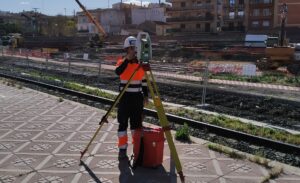We continue our series of posts on our 15 CSR commitments, this time with a theme that remains at the heart of our activities: helping to preserve our heritage and keep people safe.
Preserving and protecting is at the heart of our DNA

We provide monitoring, engineering and consultancy expertise to infrastructure builders and owners. Our mission is to monitor the condition and behaviour of assets throughout their lifecycle to ensure the safety of their users.
At Sixense, we are also committed to the preservation of territory and cultural heritage, placing environmental issues at the heart of our development projects.
We support public authorities and organisations in implementing solutions to adapt to climate change. At Sixense, we also support public and private stakeholders in implementing solutions to adapt to climate change.
Working every day for sustainability and safety
Every day and in all our activities, we work to make infrastructures more sustainable and ensure the safety of their users. We contribute to the preservation of territories by helping to reduce demolition and reconstruction operations in favour of an approach focused on extending the life cycle of structures.
These missions are delivered through our expertise:
- Specialised engineering to safeguard and optimise operations
- Instrumentation and monitoring solutions for soil, assets and the environment
- Digital business solutions to enhance the value of infrastructure and its lifecycle
Our actions on the ground
Devoting our expertise to climate change adaptation
 Through Resallience, our design office specialised in climate change adaptation, we are involved in various climate change adaptation projects and missions around the world.
Through Resallience, our design office specialised in climate change adaptation, we are involved in various climate change adaptation projects and missions around the world.
In France, for example, we have developed a modelling tool and consulting services to identify vulnerabilities to climate hazards in social housing.
A multidisciplinary and systemic study carried out by Resallience fed into a Resilience Performance Diagnostic tool used by CDC Habitat as well as Action Logement (a French public housing organisation) to better anticipate and manage needed investments to improve the quality of life and safety of tenants. As a result, 50,000 social housing units have benefited from a Resilience Performance Diagnostic.
Securing engineering structures after natural disasters
 At the end of 2020, Storm Alex isolated several areas, including the Upper Roya Valley in south-east France. Floods and landslides cast a tragic shadow over the region and damaged engineering assets, including a viaduct used by a regional railway for a “lifeline”, as the French national railway company calls it, connecting the Roya Valley to the city of Nice.
At the end of 2020, Storm Alex isolated several areas, including the Upper Roya Valley in south-east France. Floods and landslides cast a tragic shadow over the region and damaged engineering assets, including a viaduct used by a regional railway for a “lifeline”, as the French national railway company calls it, connecting the Roya Valley to the city of Nice.
Sixense Monitoring reacted on an emergency basis, along with rescue services, to install Cyclops motorised theodolites to ensure the safety of those repairing the viaduct and securing the structure and its surroundings while the train continued to roll over the bridge.
For the first few weeks, the train was the only means of access to the upper valley other than a helicopter, and Sixense’s measurements were reviewed in real time to authorise the train’s passage.
Contributing to preserve cultural heritage

El Carmen station, located in the city of Murcia in south-east Spain, is steeped in history. It was built in 1863.
After a series of twists and turns in the project to move the station underground, the building was preserved while the Madrid-Levant high-speed line was developed to open up the region.
Our employees based in Murcia are proud to have taken part in this project combining urban development and cultural heritage conservation, by installing sensors to measure and monitor the station and its infrastructure.
What our employees have to say